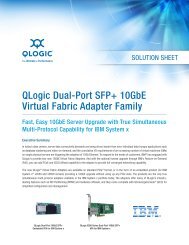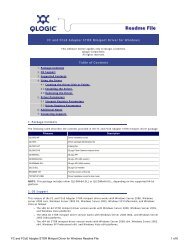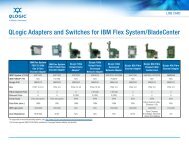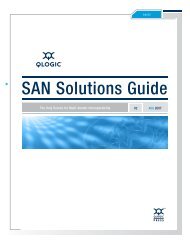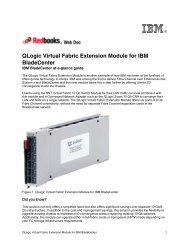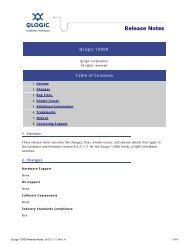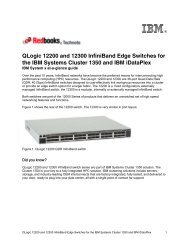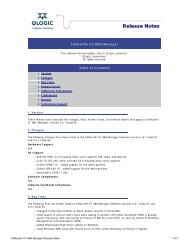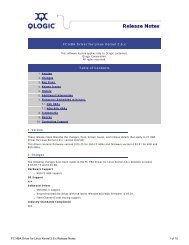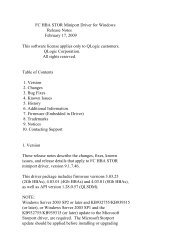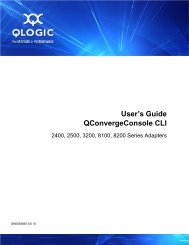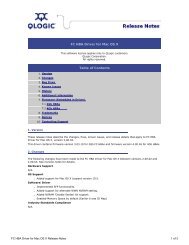Chapter 1. IBM Flex System FC3171 8 Gb SAN Switch - QLogic
Chapter 1. IBM Flex System FC3171 8 Gb SAN Switch - QLogic
Chapter 1. IBM Flex System FC3171 8 Gb SAN Switch - QLogic
Create successful ePaper yourself
Turn your PDF publications into a flip-book with our unique Google optimized e-Paper software.
Domain ID and domain ID lock<br />
The domain ID is a unique Fibre Channel identifier for the switch. The Fibre<br />
Channel address consists of the domain ID, port ID, and the Arbitrated Loop<br />
Physical Address (ALPA). The maximum number of switches within a fabric is 239<br />
with each switch having a unique domain ID.<br />
The <strong>IBM</strong> <strong>Flex</strong> <strong>System</strong> <strong>FC3171</strong> 8 <strong>Gb</strong> <strong>SAN</strong> <strong>Switch</strong> comes from the factory with the<br />
domain ID unlocked. This state means that if there is a domain ID conflict in the<br />
fabric, the switch with the highest principal priority, or the principal switch, will<br />
reassign any domain ID conflicts and establish the fabric. If you lock the domain ID<br />
on a switch and a domain ID conflict occurs, one of the switches will isolate as a<br />
separate fabric and the Logged-In LEDs on both switches will flash to show the<br />
affected ports. Refer to the <strong>IBM</strong> <strong>Flex</strong> <strong>System</strong> <strong>FC3171</strong> 8 <strong>Gb</strong> <strong>SAN</strong> <strong>Switch</strong> Command Line<br />
Interface User’s Guide for information about the Set Config <strong>Switch</strong> command and the<br />
DomainIDLock and PrincipalPriority parameters.<br />
If you connect a new switch to an existing fabric with its domain ID unlocked, and a<br />
domain conflict occurs, the new switch will isolate as a separate fabric. However,<br />
you can remedy this by resetting the new switch or taking it offline then back<br />
online. The principal switch will reassign the domain ID and the switch will join the<br />
fabric.<br />
Notes:<br />
Domain ID reassignment is not reflected in zoning that is defined by domain ID and<br />
port number pair. You must reconfigure zones that are affected by domain ID<br />
reassignment.<br />
Syslog<br />
The Syslog (Remote Logging) feature enables saving log information to a remote<br />
host that supports the syslog protocol. When enabled, the log entries are sent to the<br />
syslog host at the IP address that you specify in the Logging Host IP Address field.<br />
Log entries are saved in the internal switch log whether this feature is enabled or<br />
disabled.<br />
To save log information to a remote host, you must edit the syslog.conf file (located<br />
on the remote host) and then restart the syslog daemon. Consult your operating<br />
system documentation for information on how to configure Remote Logging. The<br />
syslog.conf file on the remote host must contain an entry that specifies the name of<br />
the log file in which to save error messages. Add the following line to the<br />
syslog.conf file. A separates the selector field (local0.info) and action field<br />
that contains the log file path name (/var/adm/messages/messages.name).<br />
local0.info /var/adm/messages.name<br />
Symbolic name<br />
The symbolic name is a user-defined name of up to 32 characters that identifies the<br />
switch. The symbolic name is used in the displays and data windows to help<br />
identify switches. The illegal characters are the pound sign (#), semi-colon (;), and<br />
comma (,).<br />
56 <strong>IBM</strong> <strong>Flex</strong> <strong>System</strong> <strong>FC3171</strong> 8 <strong>Gb</strong> <strong>SAN</strong> <strong>Switch</strong> QuickTools User’s Guide



